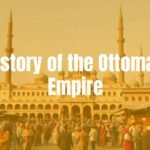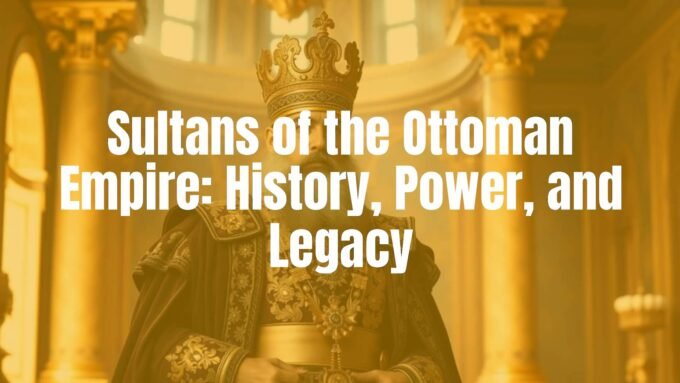The Turkish War of Independence was a key turning point in the country’s history, taking place from May 15, 1919, to July 24, 1923. It was much more than just battles; it was a movement led by the Turkish National Movement. This struggle began right after the Ottoman Empire lost World War I and was occupied and divided by Allied and separatist forces. The fight was mainly about putting the idea of self-determination into practice for Turkish people, especially in Anatolia and Eastern Thrace. At the end of this war, the Ottoman Empire came to an end, the sultanate and caliphate were abolished, and the Republic of Turkey was born.
The war changed the map and identity of the region. It set up a new, secular country. The war showed the determination of the Turkish people to fight foreign control. In the end, Turkey’s new borders and independence were recognized internationally.

What Started the Turkish Independence War?
Fall of the Ottoman Empire
The causes of the Turkish War of Independence are closely linked to the fall of the Ottoman Empire. By the start of World War I, the empire was already facing many problems, losing land, and losing power. The Committee of Union and Progress (CUP) took control after a coup in 1913, hoping to stop the empire from collapsing, but their nationalist policies only sped this up. Their decision to join the Central Powers in World War I led to greater problems for the empire.
The war led to huge suffering, including a campaign against Christian groups like Armenians, Greeks, and Assyrians. By 1918, after defeats and huge losses, the Ottoman Empire was a mostly Muslim land, but Greek and Armenian minorities remained, many of whom did not trust Ottoman rule. Losing key fronts and losing support from Bulgaria signaled the empire’s end.
Armistice of Mudros and Allied Occupation
The Ottoman Empire signed the Armistice of Mudros on October 30, 1918, ending its involvement in World War I. The agreement forced the Ottoman military to give up most of its power. However, a key part-Article VII-allowed the Allies to occupy any territory if they claimed security was at risk. The Allies quickly used this to step in.
Right after the armistice, Allied troops arrived in Istanbul on November 13, 1918, including British, French, Italian, and Greek soldiers. Publicly, the Allies said they did not plan to end the Ottoman government, but in reality, that was the goal from the start. The Allies took control of more Ottoman lands, including Mosul and key ports, making many Ottoman officers refuse to stand down-they chose to resist instead.

Plans to Divide Anatolia
The Allies had already made plans to split the Ottoman Empire through secret deals like the Sykes-Picot Agreement. At the Paris Peace Conference in January 1919, they worked to make these plans official. Italy wanted southern Anatolia, and France wanted control of Hatay, Lebanon, Syria, and more land in southern Turkey.
Greece, with Allied support, wanted to expand into areas with many Greeks. Greek Prime Minister Venizelos, with British backing, asked for territory in Eastern Thrace and around Izmir (Smyrna). Greek soldiers landed in Smyrna (Izmir) on May 15, 1919, saying their goal was to keep the peace, but Turkish nationalists saw this as an invasion, which triggered the full independence struggle.
Main Events and Stages of the War
Occupation of Istanbul and Allied Forces
When Allied soldiers entered Istanbul on November 13, 1918, it was clear the Ottomans had lost. French troops came first, followed by British, Italian, and Greek forces-about 50,000 troops in total. This occupation was supposed to protect minorities but was really about breaking up the empire.
Allied action spread beyond Istanbul: the British took Mosul, and French and Greek soldiers took control of other important areas. These actions led Ottoman commanders to keep fighting even though the Istanbul government told them to stand down.
The Greek Invasion of Smyrna (Izmir)
The real starting point of the Turkish War of Independence is when Greek troops landed in Smyrna on May 15, 1919. The Allies called this a peacekeeping operation, but most Turks saw it as an invasion.
The first open fighting began when a Turkish journalist, Hasan Tahsin, fired at the Greek soldiers. The city quickly turned into a battleground. As the Greeks moved further into the countryside, they met strong resistance from groups called Kuva-yi Milliye, which were made up of former soldiers and local people. The violence led to the destruction of towns and high tensions between Greeks and Turks.

The Nationalist Movement Grows
The Greek advance and continued Allied land grabs made Turkish society unstable and led to the rise of the nationalist movement. While the government in Istanbul tried to keep the Allies happy, nationalist groups formed in Anatolia and soon united to defend Turkish rights.
Many former leaders from the CUP and others sided with Mustafa Kemal Pasha. Sent by the Sultan to bring order, Kemal instead led the resistance, uniting different groups and making himself the central figure of the movement.
Main Congresses: Erzurum and Sivas
Mustafa Kemal started his mission in Anatolia by arriving in Samsun on May 19, 1919. Although he was supposed to disarm Turkish troops, he secretly began to organize resistance. His key step was issuing the Amasya Circular, which called for national congresses.
The Erzurum Congress (July-August 1919) was the first major meeting, where delegates wrote the National Pact, calling for Turkish unity and rejecting foreign claims. It set up a Committee of Representation led by Kemal. Shortly after, the Sivas Congress brought together representatives from all over, forming the main nationalist body (A-RMHC), strengthening Kemal’s leadership and organizing resistance from Ankara.
The Start of the Grand National Assembly
The Erzurum and Sivas congresses increased the nationalists’ power. A new parliament was elected, and the nationalist movement won most seats. Kemal, though elected, stayed in Anatolia due to Allied presence in Istanbul.
The new Ottoman Parliament supported the National Pact, but this upset the Allies, who dissolved it and arrested nationalists in March 1920. This allowed Kemal to move ahead, calling for a new parliament in Ankara. The Grand National Assembly (GNA) was set up in April 1920, with Kemal as Speaker and Prime Minister. The GNA became the center of resistance and set up a new, rival government.
Main Battlefronts of the War
Western Front: Against Greece
The biggest and most important fighting happened between Turkish and Greek forces. The Greeks, with the help of the Allies, quickly gained ground in Western Anatolia after their 1919 landing, capturing important cities. However, Turkish resistance grew stronger, especially as Kuva-yi Milliye forces became a regular army under İsmet Pasha.
Key victories at the Battles of İnönü in early 1921 turned the tide and made the Allies rethink their plans. The Greeks won at Kütahya-Eskişehir but could not reach Ankara. The turning point was the Battle of Sakarya (August-September 1921), where Mustafa Kemal led Turkish forces to push the Greeks back. After a year-long standoff, the Turks launched the final Great Offensive.

Eastern Front: Against Armenia
On the Eastern Front, Turkish forces fought Armenia, who tried to expand after Turkish troops withdrew as ordered by the Armistice. General Kâzım Karabekir refused to disband his men and repelled Armenian advances.
Thanks to support from Soviet Russia, the Turkish side was able to push into Armenian territory, leading to the Treaty of Alexandropol and later the Treaty of Kars, which set the new eastern borders and allowed Turkey to turn its attention to the Western front.
Southern Front: Fighting the French
The battles in the south were largely irregular fighting between local Turkish forces and the French, who wanted Syria and southern Turkey. The French tried to protect and resettle Armenian refugees in the area, but violence broke out. A siege in Marash caused the French to retreat and led to the deaths of many Armenians. Similar violence continued in Antep and Adana. In 1921, a truce was reached, and France recognized the Ankara government, marking the first time an Allied power made peace with the Turkish nationalists.
Uprisings and Internal Rebellion
Alongside outside threats, there were internal revolts, sometimes described as civil war. The Sultan and his supporters called the nationalists traitors and even formed the Caliphate Army to fight them with Allied backing. Several rebellions, like the one led by Anzavur and religious rulings against the nationalists, caused trouble in various regions but were eventually put down.
The Great Offensive and the Sakarya Battle
The Sakarya Battle (August-September 1921) was a major turning point for the nationalists. Under Mustafa Kemal’s leadership, the Turkish army managed to stop the Greek advance towards Ankara. This win allowed for a major counterattack, the Great Offensive, in August 1922. The Turks quickly pushed the Greeks out of nearly all of western Anatolia, recaptured Smyrna, and brought the fighting to an end.
Armistice of Mudanya and Allied Exit
After the Turkish victories, the Allies saw that the situation had changed. France and Italy led calls for a ceasefire, not wanting a new war. In October 1922, the Armistice of Mudanya was signed; Greek forces left Eastern Thrace, and the Allies eventually agreed to withdraw. This ended the occupation and set up Turkey for official recognition.

Mustafa Kemal Atatürk and Nationalist Leadership
Mustafa Kemal’s Role
Mustafa Kemal Atatürk was the main leader who united the movement and set the vision for a modern, independent Turkey. As a respected general noted for his actions at Gallipoli, Kemal used his position to organize national resistance instead of following orders from Istanbul. He called for congresses, led the new Ankara government, and became Commander-in-Chief. His steadfast decisions changed a scattered resistance into a national revolution, leading to victory and the founding of the Republic.
Other Important Figures
- İsmet Pasha (İnönü): Helped build a regular, disciplined army and was a skilled commander on the Western Front and a lead negotiator at Lausanne. Later became Turkey’s second president.
- Kâzım Karabekir: Led the Eastern Front against Armenia, securing Turkey’s eastern borders and shaping the nationalist movement.
- Ali Fuat Pasha: Organized important resistance groups in Anatolia and was an early supporter of Kemal’s direction.
- Refet Pasha: A critical military leader who helped secure Thrace after the Mudanya Armistice and represented the Ankara government in Istanbul.
These leaders, with many others, formed the core of the nationalist movement, turning local resistance into a national victory.
Diplomatic Deals and Treaties
Treaty of Sèvres: Terms and Response
The Treaty of Sèvres, signed in August 1920, tried to officially break up the Ottoman Empire. It took away large territories, gave parts to Greece, France, Italy, and the new countries of the Middle East, and reduced Turkey to a small state. Constantinople (Istanbul) and the Straits were to be managed by an international body.
Turkish people were extremely angry at these terms and protested loudly. The Ankara government called it illegal and never accepted it. The Turkish Senate refused to approve it, and the treaty was never put into practice because the nationalists kept fighting.
Treaty of Lausanne: Gaining Full Independence
The Treaty of Lausanne, signed on July 24, 1923, replaced the Treaty of Sèvres. This treaty recognized Turkey’s independence and new borders. Led by İsmet Pasha, Turkish negotiators refused any deals that would hurt their sovereignty.
Lausanne set more fair borders, ended foreign privileges (capitulations), and returned important areas like Istanbul to Turkish control. The Turkish Straits were still under international control, but this changed in 1936. The signing of the treaty marked the start of an independent, internationally recognized Turkish Republic, with Allied troops finally leaving Istanbul soon after.
Big Changes in Politics and Society
Ending the Sultanate
The War of Independence not only freed Turkey from outside rule but also led to big political changes inside the country. One of the first steps was ending the Ottoman Sultanate. Mustafa Kemal believed the monarchy couldn’t bring progress and argued for its removal. On November 1, 1922, the Grand National Assembly abolished the Sultanate. Less than three weeks later, the last Sultan, Mehmed VI, left Turkey, ending over 600 years of monarchy.
The Caliphate’s End
After the Sultanate was gone, the question remained about the Ottoman Caliphate-formerly both a political and religious authority. For a short time, Abdulmejid II was chosen as Caliph, but as reforms continued, the caliphate was abolished on March 3, 1924, as part of Turkey’s path towards secularism.
Founding the Republic of Turkey
Once the monarchy was over and Lausanne was signed, Turkey was ready for its next chapter. On October 29, 1923, the Republic of Turkey was officially declared, with Mustafa Kemal as its first President and Ankara as the new capital. This new system allowed for sweeping reforms in government, society, and culture led by Atatürk. These reforms aimed to modernize, secularize, and build a strong national identity for Turkey.
Results and Effects of the War
Population Exchange and Ethnic Changes
The independence war changed the nation’s population. As part of the Treaty of Lausanne, about 1.1 million Greeks in Turkey and about 380,000 Muslims in Greece had to move. These forced exchanges uprooted long-established communities and caused much suffering.
During and after the war, the Turkish nationalist movement followed tough ethnic policies, with violence or forced migrations targeting Christian minorities. The country’s Muslim population grew sharply, supporting the nationalists and changing the country’s demographic balance.
Lasting Impact on Turkish Society
The war left a deep mark on Turkey. The monarchy and caliphate were replaced by a secular republic. Atatürk’s reforms soon followed, targeting education, law, women’s rights, language, and clothing. These changes built the foundation of modern Turkey, though they also led to debates between those who wanted more secularism and those who preferred traditional values. The sense of a strong Turkish national identity and state grew out of this period.
Effect on Other Countries and Anti-Colonial Efforts
The success of the Turkish War of Independence showed that organized resistance could defeat powerful foreign rulers. This inspired other countries in Asia and Africa struggling against colonialism. The final settlement ended the “Eastern Question,” with Turkish people deciding their own fate. The war also contributed to changes in British politics, affected countries like Canada (which doubted its automatic support for Britain), and made people in Germany believe that harsh treaties could be reversed. The Turkish example encouraged movements for independence around the world.
| Treaty | Date Signed | Main Points |
|---|---|---|
| Treaty of Sèvres | August 10, 1920 |
|
| Treaty of Lausanne | July 24, 1923 |
|
- Mustafa Kemal Atatürk – Founder and main leader
- İsmet İnönü (Pasha) – Key commander and later president
- Kâzım Karabekir – Leader on the Eastern Front
- Ali Fuat Cebesoy – Organizer in Anatolia
- Refet Bele – Military leader and Istanbul representative














Leave a comment